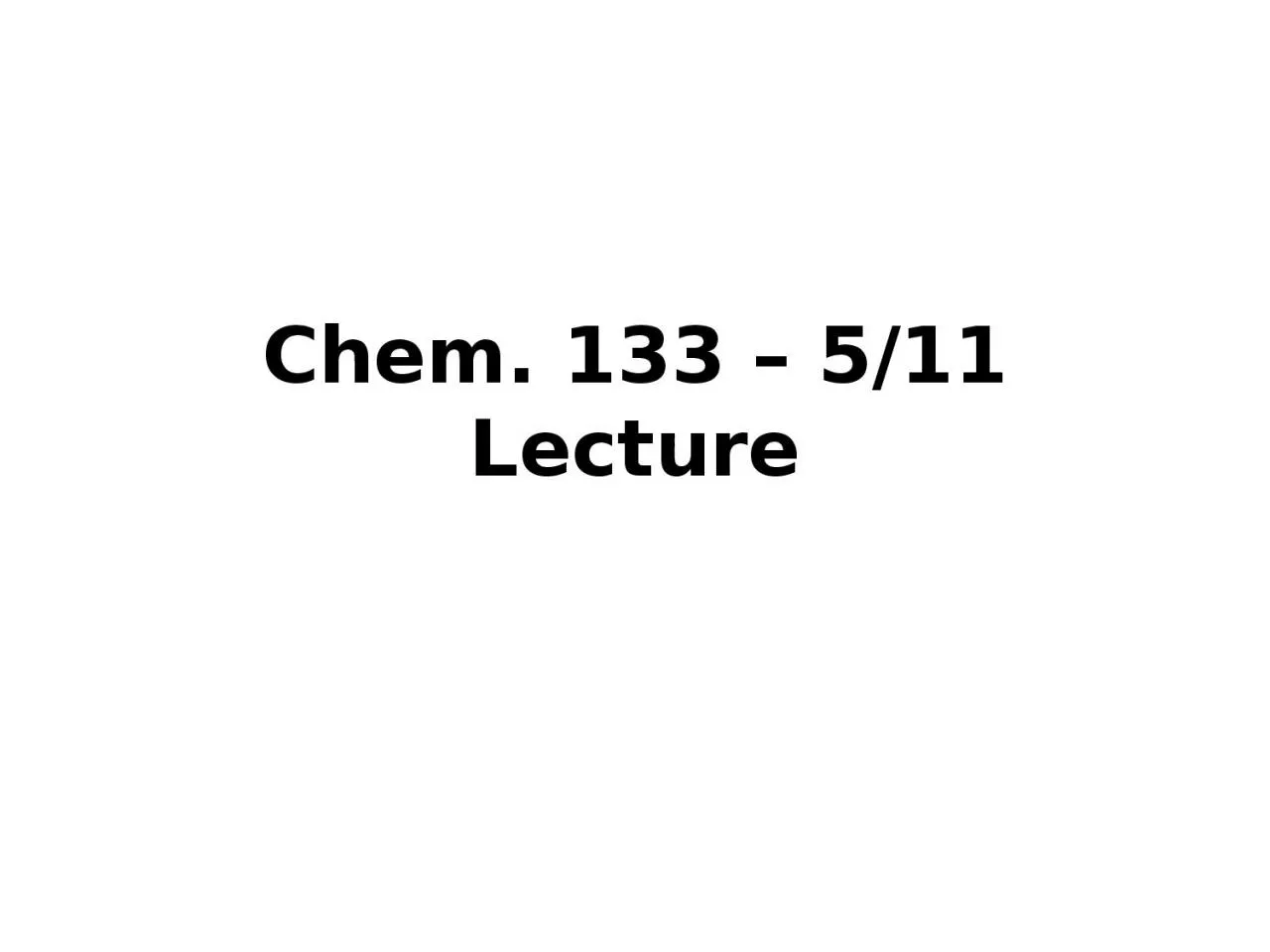

Announcements I Still grading last homework and make up quiz Posting solutions of these soon Final Exam Thursday May 18 th 1245245 About 50 Review50 New Material Allowed 1 85 x 11 sheet of notes no equations provided ID: 930681
Download Presentation The PPT/PDF document "Chem. 133 – 5/11 Lecture" is the property of its rightful owner. Permission is granted to download and print the materials on this web site for personal, non-commercial use only, and to display it on your personal computer provided you do not modify the materials and that you retain all copyright notices contained in the materials. By downloading content from our website, you accept the terms of this agreement.
Slide1
Chem. 133 – 5/11 Lecture
Slide2Announcements I
Still grading last homework and make up quiz
Posting solutions of these (soon)
Final Exam
Thursday, May 18
th
12:45-2:45
About 50% Review/50% New Material
Allowed 1 8.5” x 11” sheet of notes (no equations provided)
Reviewing new
m
aterial (since Exam 2) today
Final topic covered will be GC
Slide3Announcements II
Today’s
Lecture
Chromatography (general)
Resolution
Gas
Chromatography
Columns
Injectors
Teaching Evaluations (lecture part only)
Slide4Chromatography
Optimization
–
Resolution Equation
Will use equation qualitatively to figure out how to improve
chromatograms (don’t use to calculate R
S
from chromatograms)How to improve resolutionIncrease N (increase column length, use more efficient column)Increase a (use more selective column or mobile phase)Increase k values (increase retention)Which way works best?Increase in k is easiest (but only if k is initially small)Increase in a is best, but often hardest
not in version of text we are using
2 for 2
nd
component to elute
Slide5Chromatography
Graphical Representation
Initial Separation
Smaller H (narrower peaks)
Larger k or L - separation increases more than width
Increased alpha (more retention of 2
nd
peak)
Slide6Chromatography
Resolution/Optimization Questions
Why is it usually more difficult to improve the separation factor (
a
) when there are a larger number of
analytes
/contaminants?
Why is it effective to increase k to improve resolution ONLY if k is small to begin with?If the resolution between 2 pairs of peaks is 1.20 with an HPLC column length of 100 mm, what column length (same packing material) is needed to get to a resolution of 1.50?
Slide7Chromatography
Optimization
–
Some Questions
Indicate how the chromatograms could be improved?
Slide8Gas Chromatography (GC)
Introduction – Overview of Topics
Applications
Most common for volatile compounds
More common for non-polar to moderately polar compounds
Columns (packed vs. open tubular)
Sample Injection
Detectors
Slide9GC
Columns
Two Common Formats
Packed columns (older style)
Open tubular (typically long columns with small diameters)
Advantages of open tubular columns
Greater Efficiency
Better sensitivity with most detectors (due to less band broadening vs. lower mass through column)Advantage of packed columnsGreater capacity
Open Tubular(end on, cross section view)
Column Wall (fused silica)
Mobile phase
Stationary
phase
Slide10GC
Stationary Phase
Selection of stationary phase affects k and
a
values
Main concerns of stationary phase are: polarity, functional groups, maximum operating temperature, and column bleed (loss of stationary phase)
Type
Functional Groups
Polarity
OV-1
methyl
Non-polar
OV-17
50% methyl/50% phenyl
Somewhat polar
OV-225
Cyanopropyl, methyl, and phenyl
More polar
carbowax
Ether groups
polar
Slide11GC
Injection
Liquid Samples
– Most Common
Overload (solvent or sample) is a common problem
split/
splitless
injector minimizes this (next page)Gas SamplesSyringe Injection (standard injector)Fixed Loop Injectors (common for HPLC)Solid Phase Microextraction (SPME)
Slide12GC
Sample Injection –
Split/
Splitless
outside
Septum
Syringe port
He in
To Column
Split vent
Split valve
liner
Split/
Splitless
Injectors
Injectors capable of running in two modes: split and
splitless
Split injections used to avoid overloading columns
Injection Process
Syringe pierces septum and depressing plunger deposits liquid
Analyte
volatilizes
Part injected (usually smaller fraction)
Part passed to vent
Fraction vented depends on split valve
Slide13GC
Injection
Split injection is used for:
Higher concentrations
Smaller diameter (OT) columns
Greater need for high resolution than high accuracy
In split injection, solvent overload is less problematic
Splitless injection is used for trace analysis (~50% of injected sample put on column)
Slide14Topics Since Exam 2
Mass Spectrometry Topics
Isotope effect calculations*
Multiple charging calculations to determine M and z*
MS-MS use
Chromatography
Liquid – liquid partitioning equation*
How reactions in water (e.g. acid/base) affect distribution between two phasesPartitioning Equation in Chromatography*Qualitative understanding of effect of partition coefficient on retention on a chromatographic column*Means be able to solve problems
Slide15Topics Since Exam 2
Chromatography – cont.
Determination* and meaning of retention factor
Factors affecting retention factors in GC and HPLC
Knowledge of normal and reversed phase HPLC
Relate partition coefficient and retention factor (including calculation of volumes)*
Determination* and meaning of relative retention
Practical ways to change retention in GC and HPLCRelationship between volume, flow rate and time*What factors affect relative retentionMeaning of plate number (N) and plate height (H)
Slide16Topics Since Exam 2
Chromatography
– cont
.
14. How
to calculate N and H from
chromatograms*
Three causes of band broadening and how each depends on flow velocityMeaning of resolution and how to calculate it from chromatograms*Ways to improve resolution and applications to specific separationsGas ChromatographyAdvantages of open tubular and packed columnsColumn stationary phasesInjectors (for different sample types)